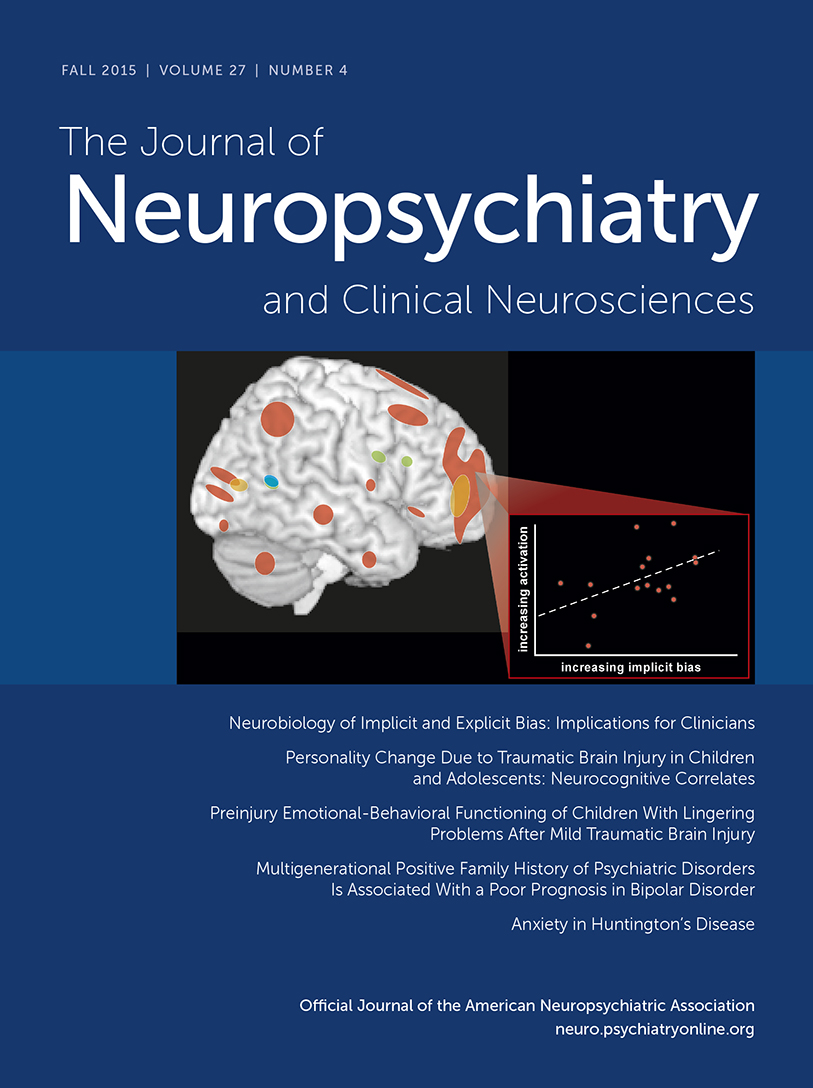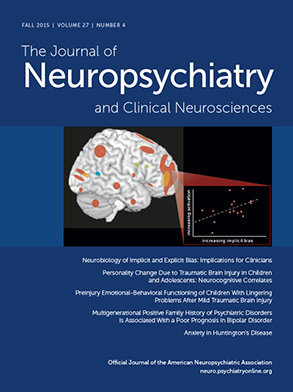PC has five specific subtypes: affectively labile, aggressive, disinhibited, apathetic, and paranoid. The first three subtypes are common and often co-occur, whereas the latter two subtypes are uncommon.
5 Studies show that most, if not all, cases of PC are accounted for by having at least the affectively labile subtype with impairing irritability.
3 The irritability has numerous potential antecedents, including a frustrated need for constant attention, sensitivity to criticism, concrete thinking, delay in gratification, unpredictability or change in routine, intellectual or concentration deficits increasing the effort in task completion, communication difficulties resulting in misunderstanding humor and instructions, and sensitivity to pain or accidental mild injury.
5 The course of PC is continuous, rather than episodic. The temper tantrums or rages that are associated with PC may be interspersed with euthymia or with persistent irritability, varying case by case. PC manifests as a disorder of mood regulation with associated behavioral disruption. Consequently, PC rarely occurs alone as a new-onset psychiatric disorder after TBI. The comorbid new-onset disorders include anxiety disorders,
8 depressive disorders,
9 mania/hypomania,
10 attention deficit hyperactivity disorder (ADHD),
2 and oppositional defiant disorder.
2 There are a number of misperceptions regarding the diagnosis of PC. Most importantly, PC is not a personality disorder. Rather, PC is a collection of clinically significant symptoms, which are described by its phenomenologically evocative named subtypes. Children, adolescents, and adults who develop PC are so impaired and radically altered as to be considered to have had a change in their personality.
PC occurs in up to 40% of cases of consecutively hospitalized children with severe TBI.
2 The disorder is significantly associated with measures of severity of injury, rather than psychosocial variables.
2–4 PC is associated with lesions within the superior frontal gyrus within the first year postinjury,
3,4 consistent with proposed models of affective dysregulation.
11–13 In the second year after injury, PC is associated with frontal white matter lesions and preinjury adaptive function, suggesting that function is limited by network (rather than by gray matter) damage as well as by the preinjury brain-behavioral reserve within each individual.
4In the absence of studies of the neurocognitive correlates of PC, our approach was to examine the relationship of PC with neurocognitive domains that are each known to be sensitive to the effects of TBI. These domains include attention, processing speed, verbal memory, intellectual function, working memory, executive function, naming, expressive language, and motor speed.
14 Pediatric TBI studies generally have found that motor inhibition measured by the Stop Signal Task is not significantly related to brain injury and is only even inconsistently related to the diagnosis of postinjury new-onset (secondary) ADHD.
15 We thus did not expect PC to be related to motor inhibition, although emotional and/or behavioral disinhibition is present in PC.
Results
Of the original 177 children and adolescents, 141 (80%) returned for the 6-month psychiatric assessment. The returning participants were not significantly different from those who did not return, in regard to age, race, gender, Glasgow Coma Scale score, or socioeconomic status. PC occurred in 31 (22%) of 141 patients at some point from the time of injury to the 6-month assessment. However, in five cases, the symptoms of PC remitted before the 6-month assessment, yielding 26 (18%) of 141 unremitted cases of PC. The affectively labile subtype occurred in 23 of the 26 cases. Of the three children with PC who did not meet criteria for the affectively labile subtype, two were diagnosed with the aggressive subtype of PC, and one was diagnosed with the disinhibited subtype. A detailed list including each child diagnosed with PC, along with their PC subtypes and specific brain lesions, was previously published.
3 As in previous reports, comorbidity is common.
2 Unremitted PC was significantly associated with the following unremitted new-onset disorders: 1) new-onset ADHD was present in six of 19 children with PC versus 11 of 96 children with no PC (Fisher’s exact test=0.035); and 2) new-onset oppositional defiant disorder/conduct disorder/disruptive behavior disorder, not otherwise specified, was present in seven of 24 children with PC versus four of 110 children with no PC (Fisher’s exact test=0.001). PC was not significantly associated with new-onset unremitted depressive disorder (major depression/dysthymic disorder/depressive disorder, not otherwise specified), which was present in only six children, including three of 25 children with PC versus three of 113 with no PC (Fisher’s exact test=0.073). The denominators differ for the above disorders, depending on preinjury diagnoses (e.g., children with preinjury ADHD would not be eligible to develop new-onset ADHD).
Table 2 and
Table 3 provide details on the relationship between each neurocognitive domain and PC.
Table 2 demonstrates large effect sizes for processing speed (d=0.89) and full-scale IQ (d=1.14); moderate effect sizes for verbal memory (d=0.66), verbal working memory (d=0.73), expressive language (d=0.73), executive function (d=0.68), and attention (d=0.54); small effect sizes for naming (d=0.36); and trivial effect sizes for motor speed (d=0.13) and motor inhibition (d=0.17).
Table 3 illustrates in detail the linear regression analyses of the 10 neurocognitive domains and their respective relationships with PC, controlling for injury severity as measured by the Glasgow Coma Scale score, socioeconomic status, and preinjury ADHD (present versus absent). PC was independently related to full-scale IQ (p=0.04), divided attention (p=0.02), processing speed (p=0.01), verbal memory (p=0.01), verbal working memory (p=0.02), and executive function (p=0.01), but PC was not significantly related to naming, expressive language, motor speed, or motor inhibition. Consistent with extensive literature, naming/reading was significantly related to socioeconomic status.
33 Expressive language was significantly related to injury severity and socioeconomic status. Motor speed was significantly related to injury severity. Motor inhibition was related to ADHD at a trend level.
All statistical analyses reported in
Table 2 and
Table 3 were repeated comparing only the participants with the affective lability subtype of PC (N=23) versus all other participants. The results were essentially unchanged.
Discussion
The most important finding from this investigation is that PC was significantly associated with deficits in important neuropsychological domains, including intellectual function, processing speed, divided attention, verbal memory, working memory, expressive language, and executive function. Furthermore, these associations (except for expressive language) remained significant even when severity of brain injury, socioeconomic status, and preinjury ADHD were taken into account.
The relationship between PC and neurocognitive function is clearly not uniform, as evidenced by effect sizes ranging from large to small. This is not surprising, given previous brain lesion-behavior correlates implicating the dorsal frontal area, especially the superior frontal gyrus, in PC. The weak relationship between PC and reading and expressive language may be because these neurocognitive domains are relatively crystallized and are more closely related to socioeconomic status than to a specific pattern of brain damage.
33 Neurocognitive processes including executive function, verbal memory, working memory, and attention, which are mediated by frontal networks,
14 might be expected to be deficient in children with disrupted affective regulation caused by damage to similar or overlapping neuronal networks. As anticipated, our negative Stop Signal Task findings suggest that problematic motor inhibition is distinct from the disinhibition or overreactivity of emotional response characteristic of PC.
Individuals with TBI are known to have difficulty understanding negative emotions such as anger, sadness, and fearfulness compared with positive emotions such as happiness,
34,35 and this may be associated with marked increased reactivity to negative emotional stimuli manifested verbally or behaviorally in children with PC. Furthermore, children with TBI exhibit impairments in understanding a form of affect regulation involving social suppression of emotional expressions.
34,36 Ecologically, better understanding of affect regulation predicts less rejection-victimization in the classroom.
37The relationship between PC and the neuropsychological domains studied is strikingly similar to the corresponding relationship previously reported for another condition characterized by significant affective dysregulation, namely bipolar disorder.
6 For example, the respective effect sizes for bipolar disorder and PC are as follows for the specific neuropsychological domains: verbal memory (d=0.77 versus d=0.66), attention (d=0.62 versus d=0.54), executive function (d=0.60 versus d=0.68), working memory (d=0.60 versus d=0.73), naming/reading (d=0.40 versus d=0.36), and motor speed (d=0.33 versus d=0.13). The corresponding relationship between bipolar disorder and PC with full-scale IQ (d=0.32 versus d=1.14) was notably different, a finding driven most likely as a result of the association of IQ and PC with greater severity of injury.
2 Another less striking difference from a recent study suggested a significant relationship with a small effect size between bipolar disorder and motor inhibition on the Stop Signal Task, in contrast with the trivial relationship in this study.
38It is difficult to outline a clear mechanism whereby affective dysregulation, which is the core feature of PC (and an important feature of bipolar disorder), is related to the neurocognitive findings. One possibility is that the pattern of brain network damage leads independently to both PC and neurocognitive dysfunction. Clinically, this seems likely because affective dysregulation and neurocognitive problems are evident within the first few days of brain injury in children. Another possibility is that regulation of affect is modified by multiple neurocognitive processes. For example, individuals with slow processing, problematic divided attention, and poor memory may become overwhelmed and frustrated by environmental and interpersonal stimuli. Deficits in their working memory, planning, and problem-solving ability may lead to selection of more angry or aggressive responses because of difficulties working adaptively with new challenges. A third possibility is that the affective dysregulation leads to the array of neurocognitive problems, although this is much less likely because the child’s explosive irritability, although frequent, is not constant and is generally not present during the formal neurocognitive testing.
Our findings must be appreciated within the context of limitations of this study. First, the neurocognitive measures administered in this study included a broad array of domains known to be sensitive to brain injury. However, more specific neurocognitive measures—as well as psychophysiological and functional brain imaging modalities targeting recognition and understanding of negative emotion, suppression of emotional expression, and executive function with emotional distractors—were not used. This limited the potential for a more in-depth understanding of mechanisms underlying the expression of PC. Second, a continuous measure of affective lability might shed more light on the relationship with neurocognitive domains. Third, attrition was approximately 20%. However, participants were not significantly different from nonparticipants with respect to age, race, gender, injury severity, and socioeconomic status. Fourth, this study examined only the short-term (6-month) outcome of PC and its relationship with neurocognitive measures. We intend to examine whether the relationships reported here are sustained in regard to PC persisting to 12 and 24 months postinjury in the same pediatric TBI cohort.
Strengths of the study should also be appreciated. The cohort studied is a large sample of nonreferred consecutively hospitalized children and adolescents, with semistructured psychiatric interviews and standardized neuropsychological tests encompassing multiple domains of function. Data reported in this study extend previously published findings that focused on psychosocial and lesion correlates of PC in the same cohort. The investigation of the neuropsychology of PC is a unique aspect of this study.

